Keeping a freshwater aquarium is undoubtedly rewarding, but occasionally, unexpected obstacles may arise. One such challenge is the appearance of white fuzzy growths, which can cause concern among aquarium enthusiasts. This comprehensive article teaches how to identify these growths as well as how to prevent them, dive in!
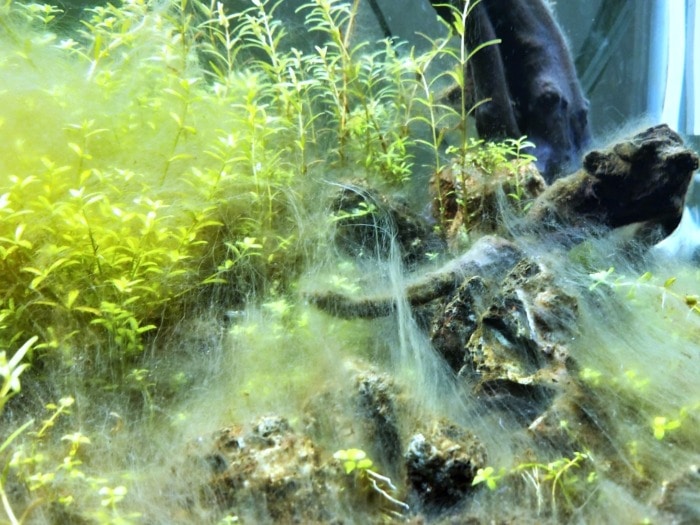
For example, years back, I started noticing some white fuzzy stuff growing in my new fish tank.
At first, the cotton-like fuzz grew on my driftwood but later I saw it taking over the bottom of my aquarium as well.
The fuzzy substance was spreading onto the substrate and the tank’s glass.
Naturally, I was worried that it may not be safe for my fish and eventually harm them.
Initially, I thought I was dealing with white algae of some sort in the fish tank. It turned out, however, that it was likely a water mold that would often cover new decorative pieces, plants, rocks, and driftwood.
Ever since I’d sometimes need to deal with this white stuff growing in fish tank when adding new decor to even my established tanks.
But how can you get rid of this nuisance?
Why did the white fuzz appear in your fish tank anyway, and is it really a fungus or stringy algae?
Let’s see!
What is the white fuzzy substance in my fish tank?

The white fuzzy-looking stuff in aquariums that grows on the surfaces in your aquarium would often be referred to as “white algae”.
However, if you’re dealing with cottony growth in your fish tank, then it’s most likely whit e molds or water molds in the fish tank.
These molds are basically species of microscopic aquatic fungi.
Even though filamentous and Staghorn algae can sometimes appear white, they don’t spread as rapidly as the fluff, caused by fungus.
Furthermore, algae are more stringy and don’t appear as fluffy or cottony as water molds.
With that being said, there are ways to prevent and treat both white stuff and algae in aquariums.
To do that, it’s essential to understand what the white stuff in the aquarium is:
The appearance of white fuzzy stuff in a fish tank often prompts concern among aquarium enthusiasts, who may mistakenly attribute it to algae growth.
The white hair algae or fluffy growth in your fish tank is actually water molds, usually from the genera Achlya, Leptolegnia, and Saprolegnia.
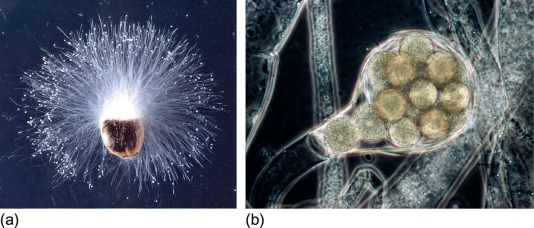
The cotton-like substance in aquariums consists of fungus filaments that break down the decaying organic matter inside your aquarium. These filaments are natural for the aquatic environment.
The misconception regarding white stuff growing in the fish tank is due to the lack of understanding about the true nature of the substance.
Aquarium owners may observe white stuff growing in their tanks, resembling what is commonly referred to as “fuzz algae.”
However, upon closer examination, it becomes apparent that the behavior of this substance deviates significantly from typical algae. Water molds do not possess the ability to undergo photosynthesis like algae as they lack chlorophyll.
Instead, they rely on consuming decaying organic matter found within the aquarium, such as leftover fish food, dead plant material, or deceased fish. As they reproduce, they form a white, cotton-like fuzz that spreads across surfaces within the aquarium.
To address the issue of white stringy stuff in fish tanks caused by water molds, prevention and maintenance are key.
Consistent maintenance of the aquarium, removal of leftover food, and performing routine water changes can help reduce the buildup of decaying organic matter, thereby decreasing the favorable environments for the white stuff floating in the tank.
Maintaining optimal water quality parameters and ensuring adequate water circulation are also essential for creating an environment less favorable to water mold growth. By taking these proactive measures and understanding the true nature of the white fuzz in aquariums it is important for enthusiasts to effectively manage water mold infestations.
Is this white fuzz harmful to your pet fish and other aquatic inhabitants?
Generally, most water molds in fish tanks aren’t harmful to your pet fish.
Usually the term “white algae“ may suggest a harmless presence, nut the reality is that unchecked growth of mold can have negative consequences to fish health.
Nevertheless, if there’s too much mold in your tank, and it’s a Saprolegnia species, it may try to transfer itself to your aquatic pets. In such cases, fungal infections appear as white fuzzy patches on the body and fins of your fish (visit the link and scroll down to see more pictures).
Uncontrolled growth of water mold or white fuzz in fish tanks can lead to creating an environment favorable to the development of fungal infections in fish. In severe cases, fungal infections can infiltrate deeper into the fish’s tissues, thereby causing systemic infections that compromise the fish’s overall health and immune system.
Fungal infections in fish can result in a range of symptoms, including lethargy, loss of appetite, abnormal swimming behavior, and visible lesions or ulcers on the fish’s body.
Is white algae dangerous? Yes, this can be dangerous for your fish, as the Saprolegnia may start breaking them down alive.

This then turns into a disease, known as Saprolegniasis. If left untreated, the infection can progress rapidly, causing tissue damage, inflammation, and ultimately compromising the fish’s overall health and immune system.
Besides saprolegniasis, white fuzzy mold in fish tanks has the potential to cause other diseases and health problems in aquarium fish. The presence of white fungus on fish in the aquarium environment is suitable for the proliferation of various bacterial and parasitic infections.
For example, opportunistic bacterial pathogens may proliferate in decaying organic matter and biofilms associated with white fuzzy mold growth, leading to secondary bacterial infections.
One such disease is cotton wool disease, which is a bacterial infection that can present symptoms similar to white algae or fungal infections.
There’s no way a fish keeper at home could properly identify whether the mold growing in their aquarium is the type that’s safe around fish. Therefore, if white mold is taking over your aquarium very quickly and it spreads to more than just one place in the tank, you should treat it to prevent fish infections.
To abate the risks posed by excessive mold growth and prevent fungal infections and other diseases in fish, it’s mandatory to actively manage and control mold growth in the aquarium.
Routine maintenance practices, including cleaning the tank, removing decaying organic matter, and performing water changes, can help reduce white stuff or mold proliferation and create a healthier environment for aqurium fish.
Furthermore, monitoring water quality parameters and addressing any deviations promptly can help prevent stress-related complications and reduce the probability of disease outbreaks.
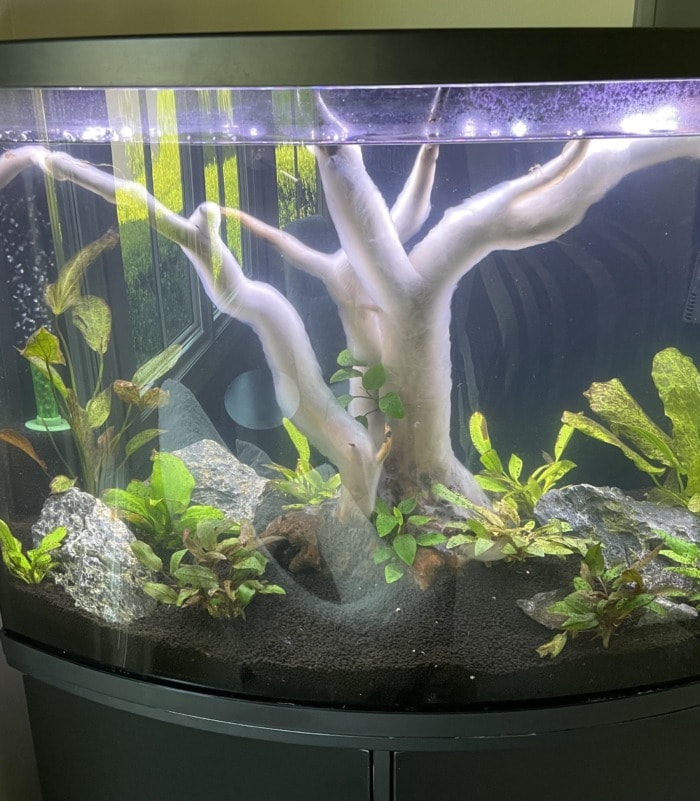
With that being said, you shouldn’t be worried if mold appears in restricted areas or on a few decorative pieces. For example, if you add a new driftwood piece to your fish tank, and a day later you see it covered in a somewhat fuzzy or slimy white film, don’t worry.
When driftwood finds itself in an aquarium, it starts releasing carbohydrates and other substances that feed the aquarium fungus and bacteria.
Even if you’ve soaked or boiled your new decorative piece in advance, the white stuff will likely cover its surface for a while.
In time, the bacteria fungus or mold will disappear on its own.
In this case, you shouldn’t worry about it, as it isn’t dangerous to your fish.
Author’s Note: Sometimes the white fuzz appears on our aquatic plants. In these cases, the plant itself probably has damaged and decaying plant matter. The dead matter then gets temporarily colonized by bacteria or fungi. White cotton-looking fungus would also sometimes appear on new rocks and aquarium glass for a short time, and all for the same reasons.
What causes white mold to appear in my aquarium?
String algae outbreaks are typically caused by too much light, or high Nitrate, and Phosphate levels. However, there are multiple common things that can cause white fuzzy mold to appear in an aquarium.
Basically, there are a few specific scenarios when this can happen and I will explain each of them below:
You have a new fish tank that is still cycling
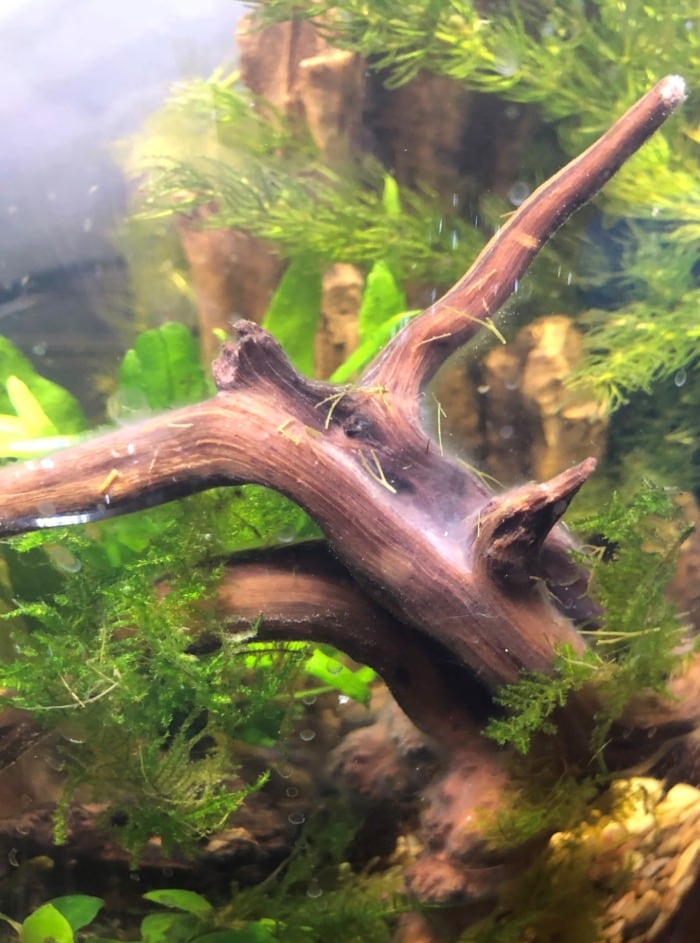
“Cycling”, also known as the Nitrogen cycle, is the somewhat long process of beneficial bacteria still establishing themselves in your new aquarium.
The white fuzzy stuff would often appear in new aquariums where the nitrogen cycle is still incomplete.
The fungus will cover driftwood if you have any, the substrate, and other aquarium ornaments rapidly.
This happens because there are not enough beneficial bacteria that would otherwise break down the excessive nutrients.
The fungi temporarily outcompete these bacteria and take advantage of the available resources in the system. But don’t worry – this is a natural process.
In time, there would be enough beneficial bacteria to displace the white mold in fish tanks in the first place battling for organic matter.
During the cycling process, beneficial bacteria colonize the tank surfaces and substrate, decomposing organic waste and transforming toxic ammonia into less toxic substances.
Once the aquarium is established and the water–stabilized, you won’t notice any more moldy fish tank.
Author’s note: If your tank has a stable Nitrogen cycle, you may not get fungus in the first place. This means that once your tank has matured you won’t have to deal with the nuisance after every addition of a new driftwood piece, for example.
Anyway, through my experience, I’ve also found that cottony mold would be very likely to develop in new fish tanks that are being cycled with raw shrimp.
That’s a common method of kickstarting the colony of beneficial bacteria in new tanks.
The fungus would first develop on the piece of shrimp and then spread some more around it.
My experience has been that this cycling method takes more time and it’s not the best approach to kickstart the Nitrogen cycle. I don’t like waiting for a couple of weeks before I can add fish to a new aquarium. If you’re at this phase and want a quicker method – check out this post to see how I recommend cycling your new fish tank faster.
You’ve added a new decorative piece

Fungus would most often appear on newly added driftwood, plants, or other ornaments that carry dead organic matter.
Introducing new decorations or plants into the aquarium without proper cleaning and quarantine measures can introduce mold spores into the tank. These spores can quickly establish themselves on surfaces, leading to the development of fish tank mold.
Before introducing new decorations, plants, or fish into your aquarium, it’s crucial to quarantine them to prevent the introduction of mold spores.
Quarantining new additions allows you to observe them for signs of white slime in the aquarium or other issues before introducing them into your main tank.
If you’ve recently put a new decoration in your tank, and it’s covered with white fuzz or slime – don’t fret.
You can wait it out, and the fungus will naturally disappear once their food source is depleted.
The filaments will only spread if there are other aquarium conditions, promoting their growth (too much organic waste, bad water circulation, low pH, etc.).
You’re overfeeding your fish

If you’re a bit too generous when feeding your fish, the food leftovers at the bottom of your tank will promote the growth of mold.
Since most of us deeply care about our aquatic pets, we tend to overfeed them.
This is especially true with Betta fish where concerned aquarists tend to feed them too many times a day.
That’s because Bettas are the common pet fish choice amongst beginners who aren’t aware that feeding their fish too much will do more harm than good.
On top of that, overfeeding could lead to abrupt ammonia spikes and subsequent fish deaths.
To avoid the appearance of white fungus in your aquarium, make sure you remove the food surplus after your pet fish finish their meal.
This way you will prevent the rapid accumulation of mulm in the tank’s substrate and the subsequent fungus infestation.
You should also come up with an adequate feeding schedule, based on the diet of the fish species you keep.
Decaying plant matter

If you have a planted tank and you’re noticing white mold in the fish tank, then you should examine your plants’ health.
If there are not enough beneficial bacteria in the tank, the fungus filaments would happily feed on the decaying plant matter and multiply. As it provides a rich food source for mold spores, thereby promoting their proliferation and the formation of white fuzzy molds on surfaces within the aquarium.
Regularly monitor your plants and trim any dead or decaying portions using sharp scissors to prevent them from deteriorating further. Use pruning shears to trim them away.
Poor water circulation
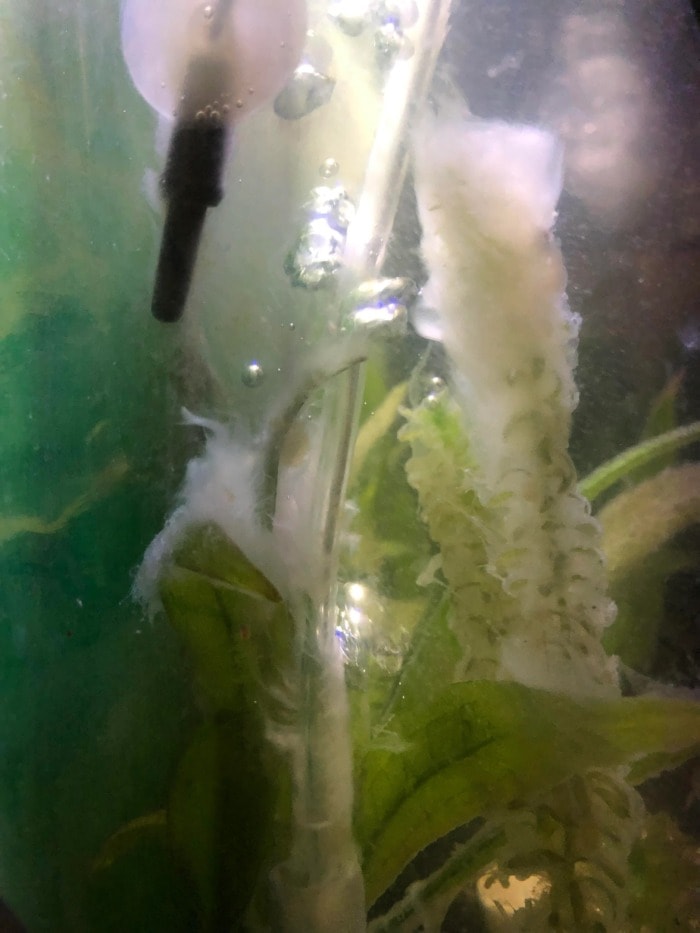
Water mold often appears in areas with stagnant water which usually are some of the corners of a fish tank.
The fungus may also develop in the dead spots inside filters that aren’t being cleaned often enough.
Sometimes when a fish swims by the dead-flow areas in the tank, pieces of the mold break apart from the movement and start floating in the tank where the actual flow pushes them around.
This is also the reason you may sometimes see floating pieces of mold right after you’ve cleaned the substrate and disturbed the dead-flow spots.
Low water pH
Saprolegnia fungus thrives in lower water ph. You can use an aquarium test kit of some sort to check your water parameters and see whether you need to increase the alkalinity. Fungus can survive in waters with a pH of 7, but if your pH is 6.5 or lower, the white slime in the aquarium will spread much faster.
However, I recommend trying all the other methods for fungus removal I’m about to list below before attempting to tweak your aquarium’s ph.
In fact, if you manage to control the waste in a fish tank with acidic water, you should not see mold spreading. The lower pH simply amplifies the effect in aquariums with waste issues.
Dead fish in the aquarium
If a fish has died in your new aquarium you should remove it right away because fungi and bacteria will start colonizing its body almost immediately. Moreover, a dead fish can cause a spike in ammonia levels in the water. If ammonia builds up and is not lowered in time it can become lethal to the remaining live fish inside your tank.
Injured fish
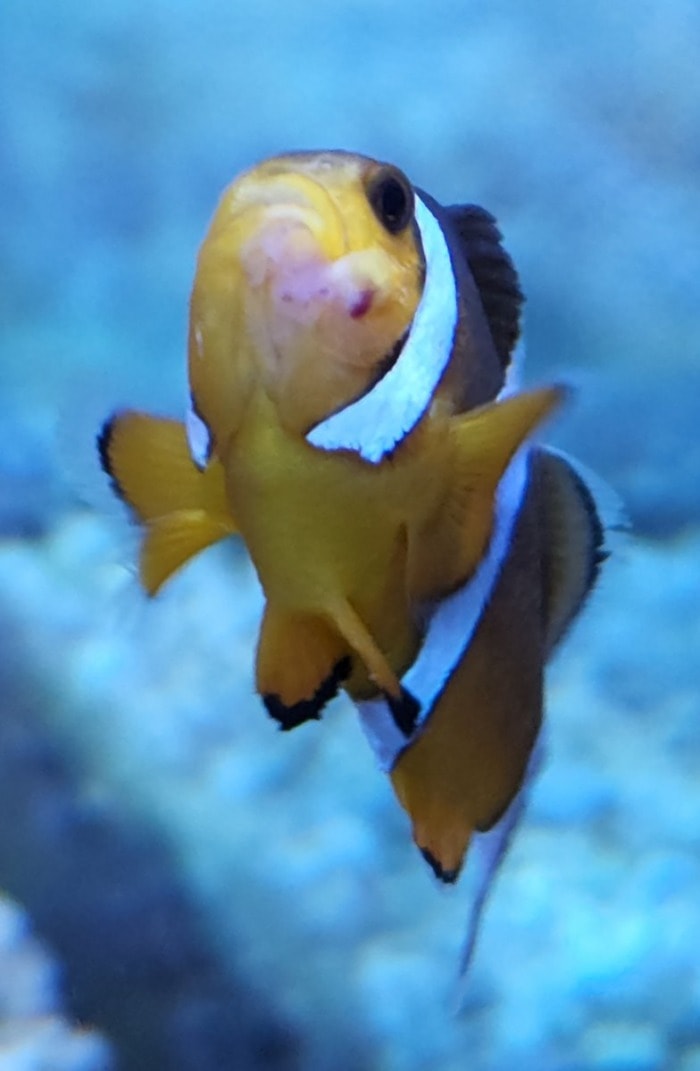
Fungus in the aquarium is also promoted if there are fish with open wounds or other injuries inside. Furthermore, Saprolegnia propagules would often adhere to injured, stressed-out fish, which can cause subsequent infection that can become lethal.
You don’t vacuum the substrate often enough
Cleaning the substrate of your fish tank once every week or bi-weekly is a good way to prevent things that get stuck in it and start to rot.
Fish food leftovers, too much fish poop, and other nasties in the substrate are to water molds and algae as gasoline is to a fire.
How to get rid of the fuzzy growth?
The white algae on aquarium glass would often disappear naturally, and therefore many experienced aquarists know they shouldn’t do anything special to get rid of it.
Nevertheless, there are ways to speed up the process.
Furthermore, if the molds are spreading rapidly and are taking over your tank, you need to do something about them.
So here’s how to get rid of white algae in your fish tank:
- Physically remove the fuzzy growth. You can vacuum off as much of the molding fish tank as you can. Don’t forget to check out your fish tank’s filters – the mold would often establish itself in there, so clean them if necessary.
Use an algae scraper or aquarium-safe scrubbing pad to gently scrape away the fuzzy growth from the aquarium glass and decorations. Avoid scratching the glass or breaking delicate decorations when removing them. For persistent growths, soak affected items in a diluted bleach solution (1 part bleach to 20 parts water) for a few minutes before scrubbing.
This is only a temporary solution, so if you don’t do something about the excess organics in the tank, the fungus will reappear. With that being said, by physically removing the moldy growth, you will suppress its reproduction momentum. - Vacuum the substrate. This way you will remove food leftovers and dead matter that may be promoting the growth of the mold. You should also check your aquatic plants’ health. Remove any decaying plant matter.
- Change 20- 30% of the water every other day. If the white mold is taking over, you should make sure to perform regular water changes that will reduce the nutrient pollution in the water. Use a siphon to remove debris and detritus from the substrate while changing water and be sure to vacuum the gravel thoroughly to eliminate any organic matter.
When the mold is under control you can switch back to weekly or bi-weekly partial water changes. - Improve water circulation: You can do that by adding an airstone to the tank. Be sure the decor is not creating areas with no flow in the tank. Sometimes simply rearranging the decor a bit solves the issue.
- Use a UV sterilizer: A UV sterilizer will eliminate the fungal spores in the water column, which will prevent the white fuzz from multiplying and spreading inside your tank.
- Nanotechnology Coatings: Aquarium glass surfaces can be coated with nanotechnology to generate hydrophobic barriers that prevent the attachment and growth of algae and fungi.
- Add mold-eating organisms like fish or shrimp: Many algae eaters, such as Amano shrimp would gladly feed on the fungus that’s growing inside your freshwater aquarium. Small scavenger fish like Otocinclus Catfish and Siamese Algae Eaters can also assist in controlling algae and mold growth in the aquarium.
- Avoid overfeeding: If you’ve been feeding your pets too generously, you should stop doing that. By feeding less, you will decrease the amount of organic waste that is feeding the fungus. The goal here is not to keep your fish malnourished but rather not to feed them more than they can eat, preventing the accumulation of food leftovers on the bottom.
- Add bottled beneficial bacteria when adding new stuff to your tank. By adding a bit of aquarium bacteria supplement upon the introduction of new plants, driftwood or even other fish you make sure there will be no “free” food for fungi.
- Ultrasonic Algae Control Devices: Ultrasonic algae control devices emit ultrasonic waves that disrupt the cellular structure of algae and fungi, including white fuzzy growths.
- Probiotic Treatments: Probiotic treatments consist of beneficial bacteria strains that engage to compete with mold spores for nutrients and space in the aquarium.
Other than that, you should also check your water’s pH and see if it’s too low.
Most freshwater aquatic molds thrive at lower pH, so this may have been helping the fuzzy stuff to spread faster. Altering the water’s pH, be it increasing it or decreasing it, should be your absolute last resort. If not done right it could do more harm than good.
Also, this does not apply to saltwater aquariums where the pH is usually high, however.
Depending on the condition of your tank, performing only one of the aforementioned steps may be sufficient to rid the system of water molds.
With that being said, if the pollution is too severe, it will take a while for the fungus to completely go away.

Final words
You shouldn’t get stressed out if you notice that your aquarium harbors white fuzz.
With that being said, if you aren’t putting enough effort into taking care of the ecosystem inside, water molds may quickly spread in your fish tank.
So proactive management and a deep understanding of white stuff growing in fish tanks are therefore essential for preserving the health environment in your aquarium. By employing a comprehensive strategy involving physical removal, substrate maintenance, water changes, and innovative interventions, fish caretakers to combat the emergence and proliferation of white fuzzy growths.
It is crucial to stay vigilant and address any signs of white fuzzy growth promptly that are of the utmost importance in order to avert their spreading and impact the overall health of the aquarium ecosystem.
Moreover, a healthy environment in the fish tank is not only essential for the well-being of the aquatic inhabitants but also for the aesthetic appeal of the aquarium.
By implementing proactive management practices and utilizing advanced technologies, aquarists can create an environment that is conducive to the growth and flourishing of fish, plants, and other aquatic life.
I hope that you found this article helpful.
Leave me a comment below if you have any questions!



